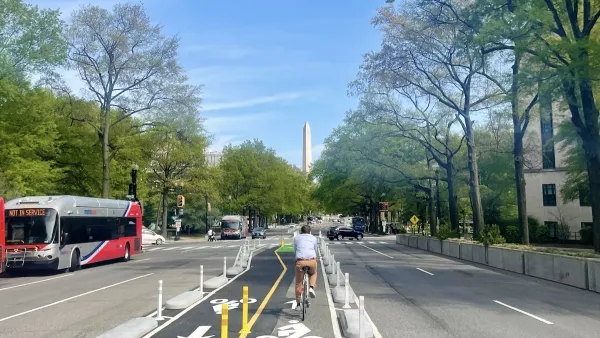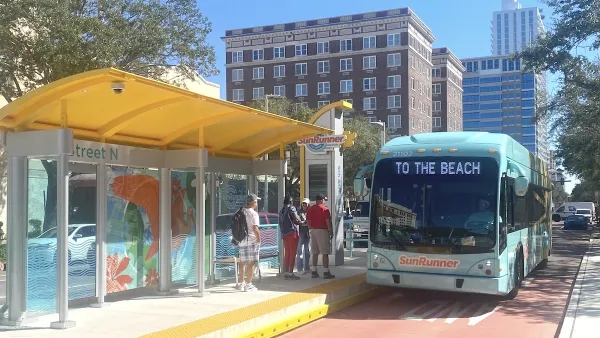The real estate market has been transformed in cites that added bus rapid transit in the past decade, according to a new study presented this week at the Transportation Research Board Annual Meeting.
According to Angie Schmitt, "a new study [PDF] by Arthur C. Nelson of the University of Arizona and released by Transportation for America finds that BRT lines can indeed shape real estate and attract jobs…" The big caveat of the study's findings: those benefits are possible "if the projects are done right."
The study "found that in Pittsburgh, Cleveland, Las Vegas, Los Angeles, and other cities with high-quality BRT lines, real estate near the routes tends to be valued at a premium and is capturing an increasing share of development," reports Schmitt.
Schmitt also provides a dispatch from Nelson's presentation at the Transportation Research Board Annual Meeting earlier this week. There, Nelson described the effect of BRT on development and real estate as transformational, and likely to continue provide benefits in the future.
The catch, however, is that merely rebranding a bus route as BRT isn't enough: "to reap the benefits of BRT investment, Nelson says cities must ensure the systems are designed and operated at a high standard….In addition to high frequencies, BRT routes that affect development have features like dedicated lanes, level boarding, off-board fare collection, and signal priority for buses at intersections…"
FULL STORY: New Evidence That Bus Rapid Transit Done Right Spurs Development

Maui's Vacation Rental Debate Turns Ugly
Verbal attacks, misinformation campaigns and fistfights plague a high-stakes debate to convert thousands of vacation rentals into long-term housing.

Planetizen Federal Action Tracker
A weekly monitor of how Trump’s orders and actions are impacting planners and planning in America.

Chicago’s Ghost Rails
Just beneath the surface of the modern city lie the remnants of its expansive early 20th-century streetcar system.

Bend, Oregon Zoning Reforms Prioritize Small-Scale Housing
The city altered its zoning code to allow multi-family housing and eliminated parking mandates citywide.

Amtrak Cutting Jobs, Funding to High-Speed Rail
The agency plans to cut 10 percent of its workforce and has confirmed it will not fund new high-speed rail projects.

LA Denies Basic Services to Unhoused Residents
The city has repeatedly failed to respond to requests for trash pickup at encampment sites, and eliminated a program that provided mobile showers and toilets.
Urban Design for Planners 1: Software Tools
This six-course series explores essential urban design concepts using open source software and equips planners with the tools they need to participate fully in the urban design process.
Planning for Universal Design
Learn the tools for implementing Universal Design in planning regulations.
planning NEXT
Appalachian Highlands Housing Partners
Mpact (founded as Rail~Volution)
City of Camden Redevelopment Agency
City of Astoria
City of Portland
City of Laramie




























